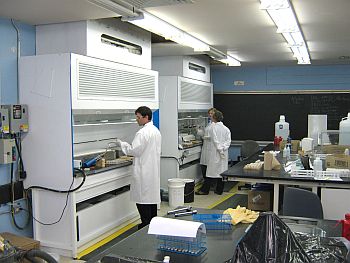 Activation Laboratories Ltd. is growing to meet demand from an increasing number of exploration and mining companies throughout Northern Ontario and the world.
Activation Laboratories Ltd. is growing to meet demand from an increasing number of exploration and mining companies throughout Northern Ontario and the world.
The expansion of its Thunder Bay and Geraldton labs, along with two recent start-ups in Quebec and one in Mexico, is proof that exploration companies are busy and confidence is gaining in the marketplace.
Ryan Mackie, Northern Ontario's regional manager, said the company is currently studying the potential for two more labs in northeastern Ontario's Abitibi Greenstone Belt. This Ancaster-based company is a strong believer in providing service close to its clients and has developed its business model around that philosophy.
"We wanted to move closer to where our client base is so we can provide analytical services in a more timely fashion," he said. "It helps out smaller communities, and it is easier for us to communicate and develop a working relationship with our clients when we're located where their projects are."
Mackie, who grew up in North Bay and Sudbury, is familiar with the region's mineral resource-based economy. He said about 75 per cent of the Thunder Bay and Geraldton lab work is fuelled by exploration. The remainder is mining-based.
The labs are fully equipped to serve the mining industry, offering everything from gold assays to high-end tests required for pre-feasibility studies, Mackie said.
"We cover the full spectrum of tests - from your basic gold assays to enzyme leach and mineral liberation analysis. We're a quality and scientifically-oriented lab. We have a large research and development department and are constantly developing new methods and technologies."
One of Actlabs' newer technologies, soil gas hydrocarbon (SGH) analysis, is used to detect minerals through overburden. It is a geochemical analysis to help exploration companies increase drilling accuracy. The technology was developed in collaboration with the Canadian Mining Industry Research Organization, the federal government, three provincial governments and 12 major mining companies.
"We've had feedback from companies that claim it has saved them 15 to 25 per cent of their drilling costs because it reduced the number of targets," Mackie said. "It's a newer technology growing in popularity. People are slowly starting to try it and see that it works."
Part of the Thunder Bay lab's renovations involves the addition of "high-end" instrumentation such as X-ray Fluorescence (XRF) and Inductively Coupled Plasma Mass Spectrometry (ICP/MS). XRF uses X-rays to detect minerals and ICP/MS is used for trace element analysis. Mackie said the company uses X-ray Fluorescence for the analysis of chromite samples in the Ring of Fire.
The company will have 100,000 square feet of lab space and 135 employees when its current expansion is completed in April.
The Geraldton lab, which opened in June 2009, is expanding from sample prep to a full gold lab and plans are underway to hire about 15 to 20 people, more than doubling its workforce.
Mackie said the turnaround time for samples depends on the number of samples coming through the door, but it is generally between one and two weeks. Twenty-four hour service can be accommodated if requested.
www.actlabs.com

